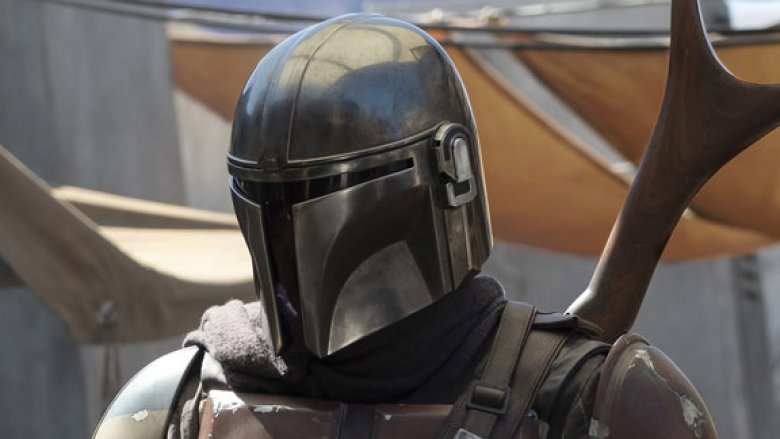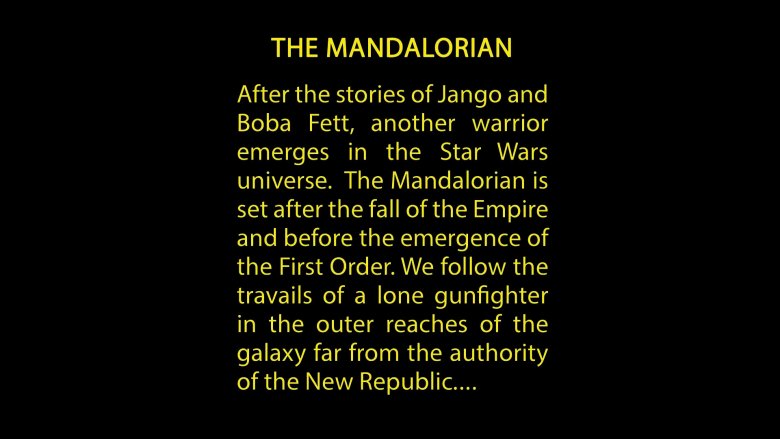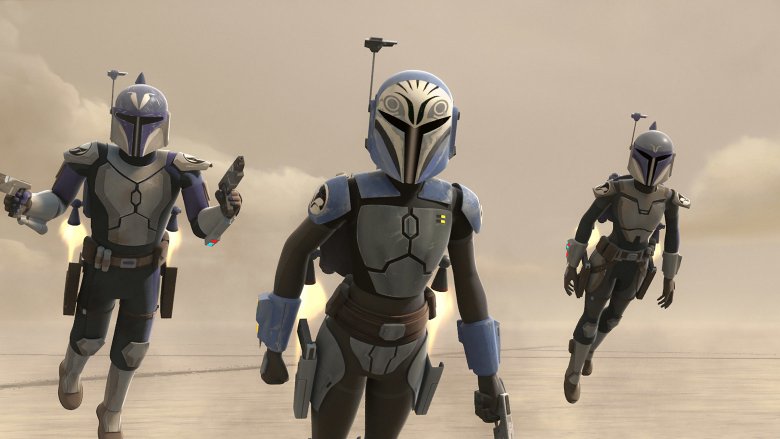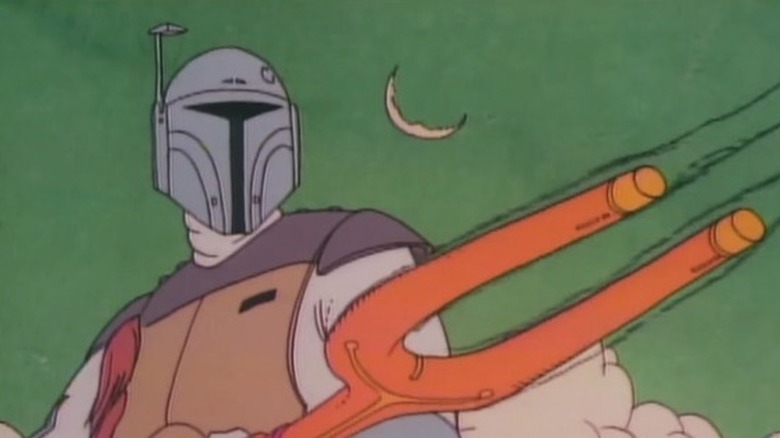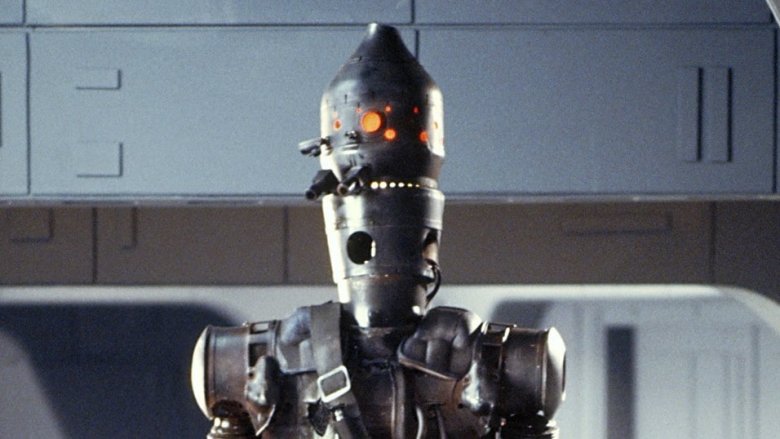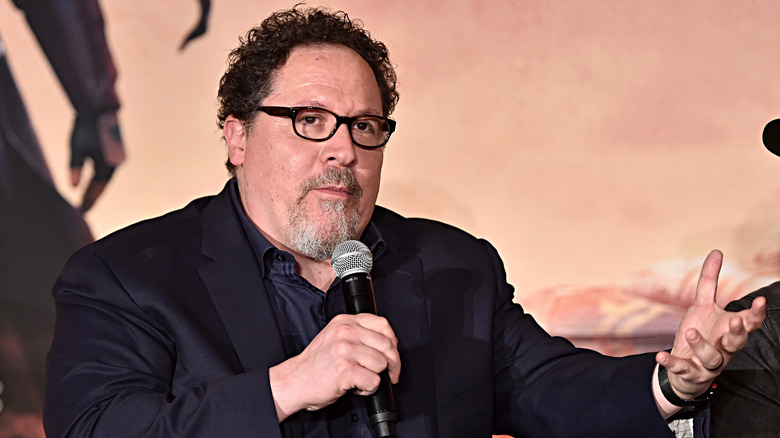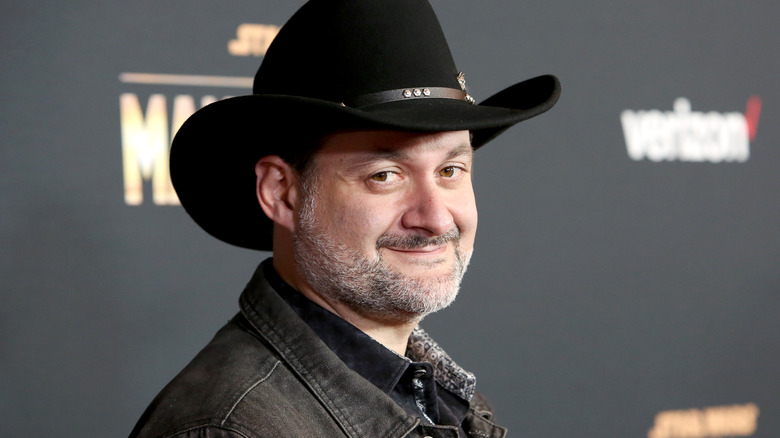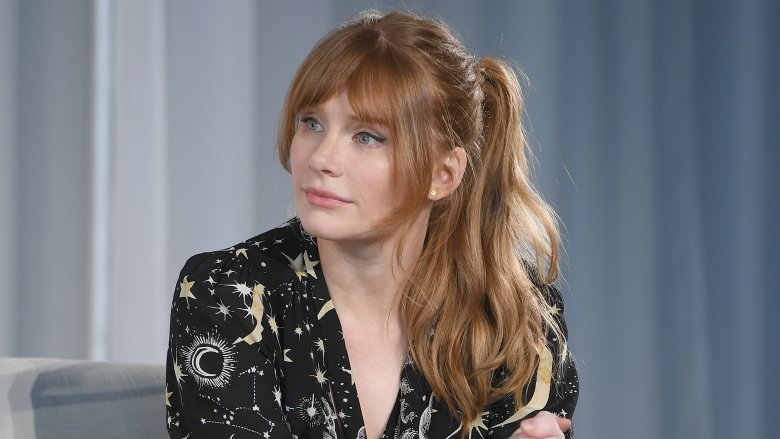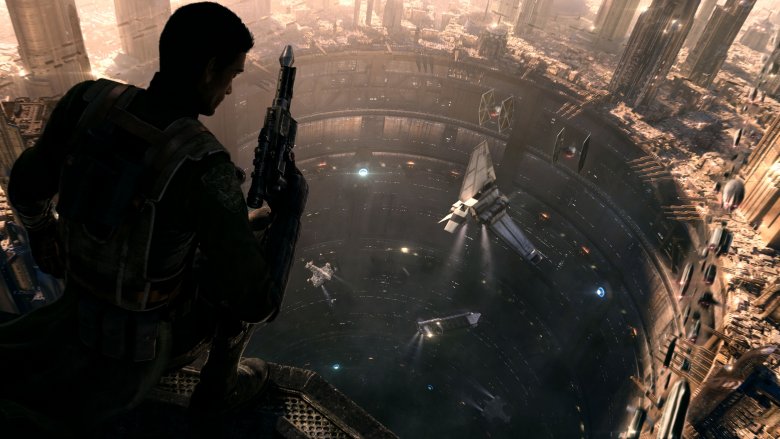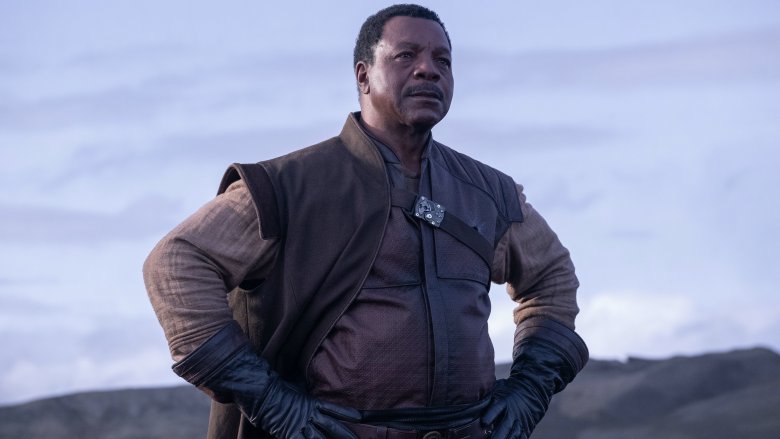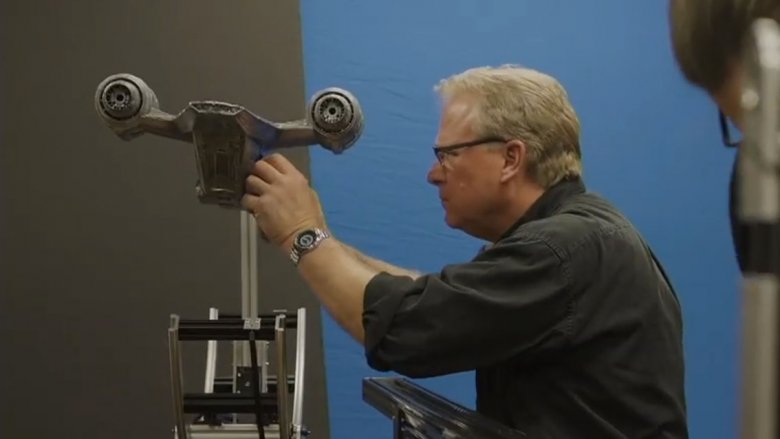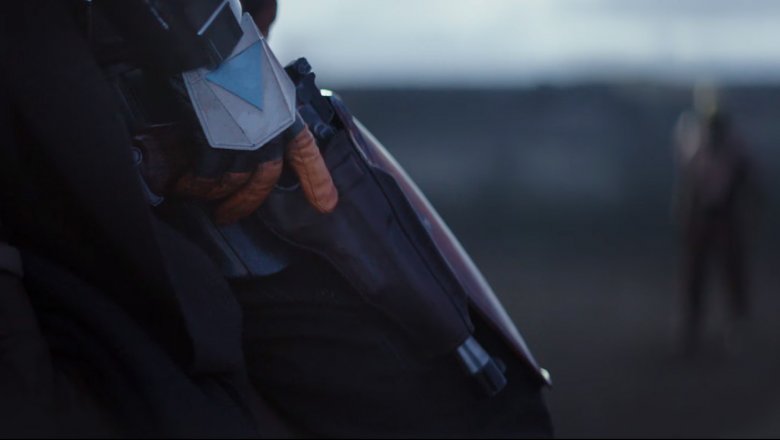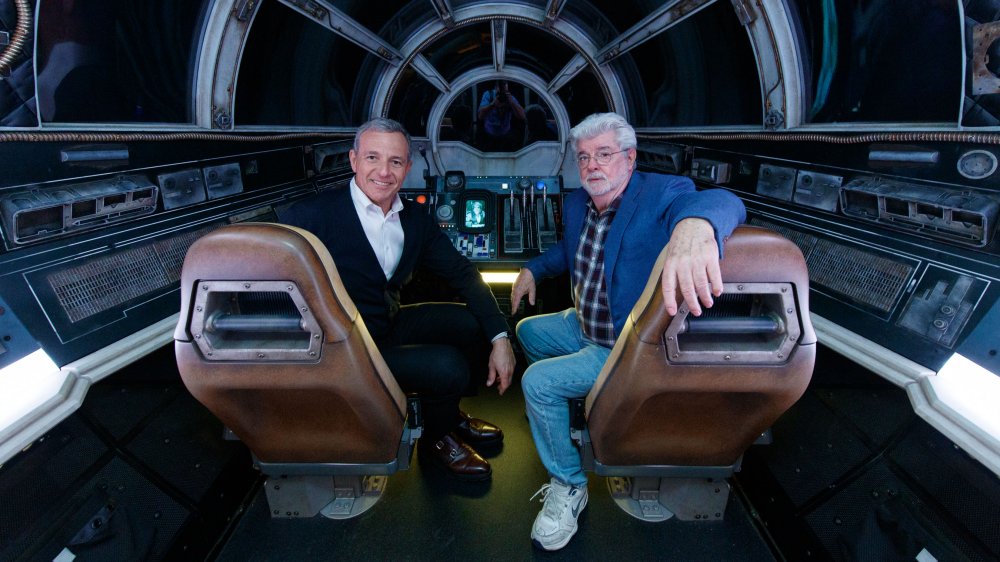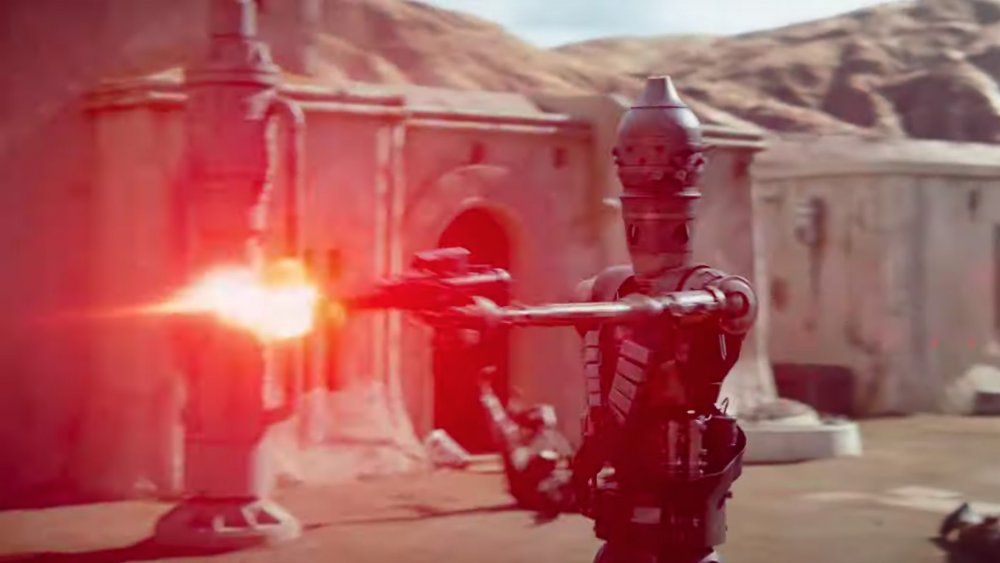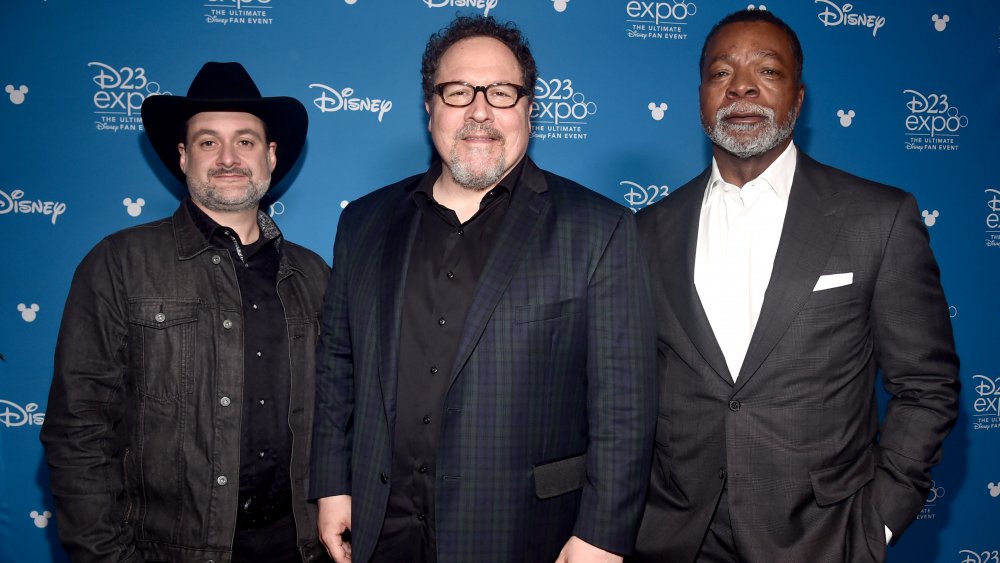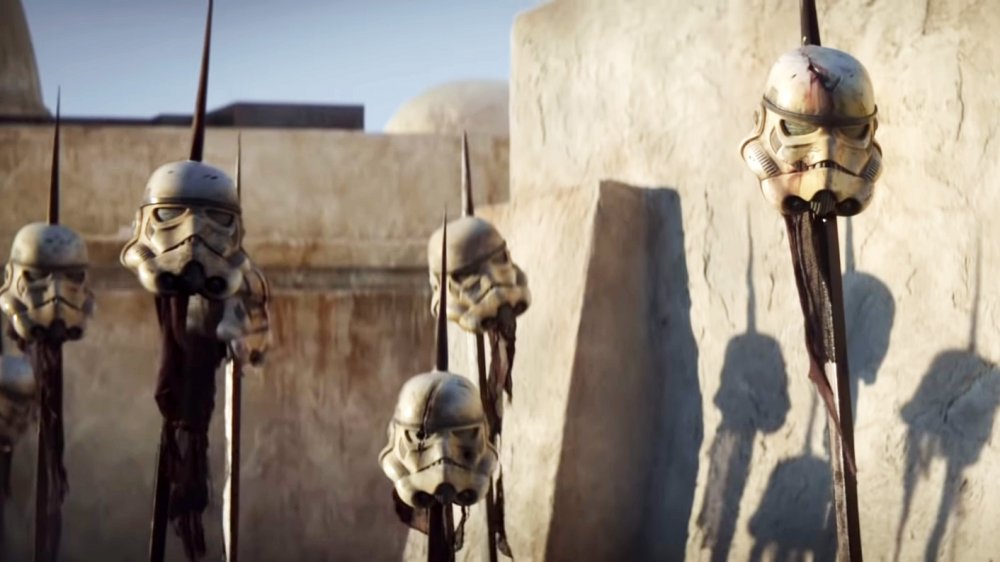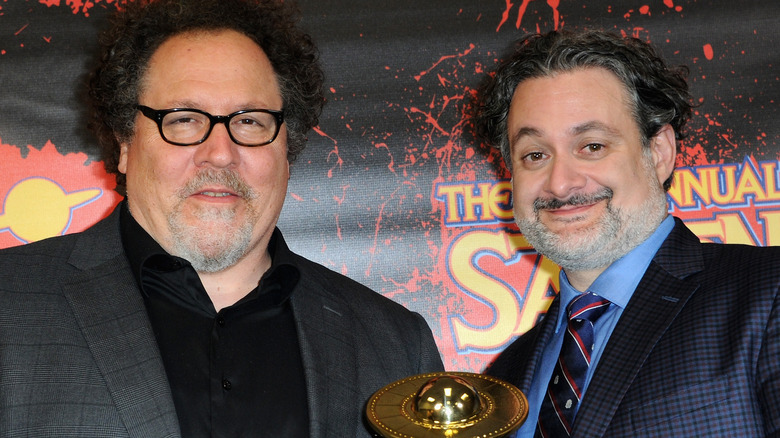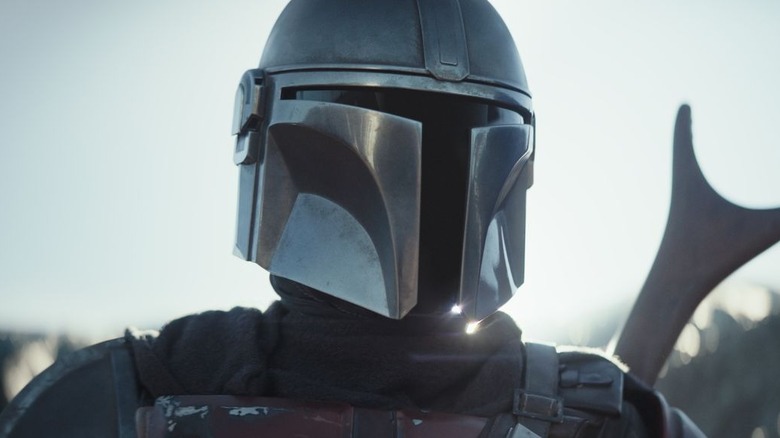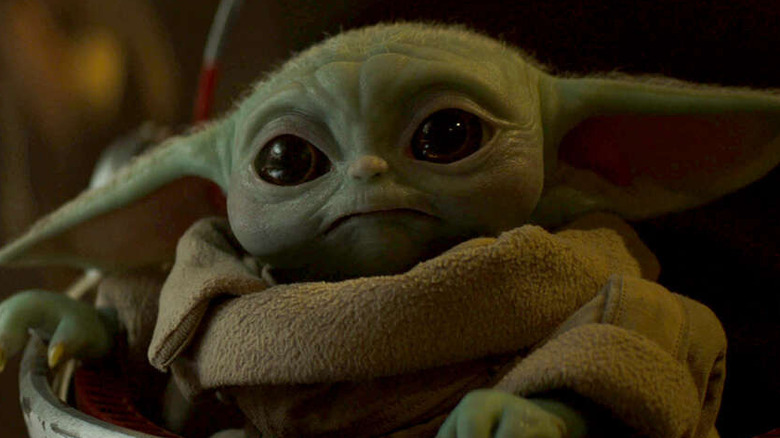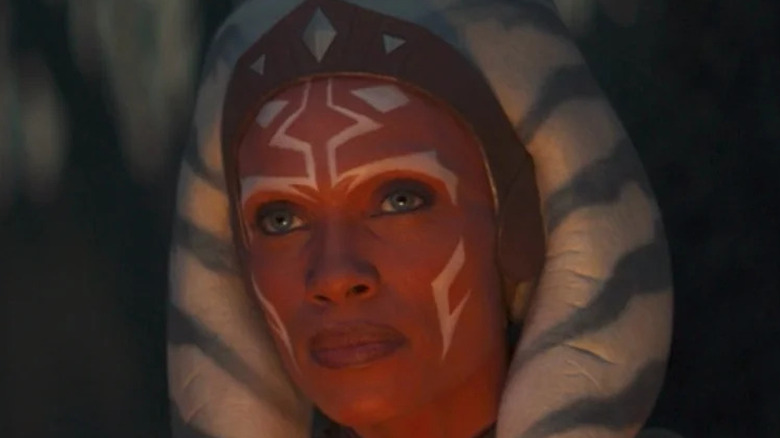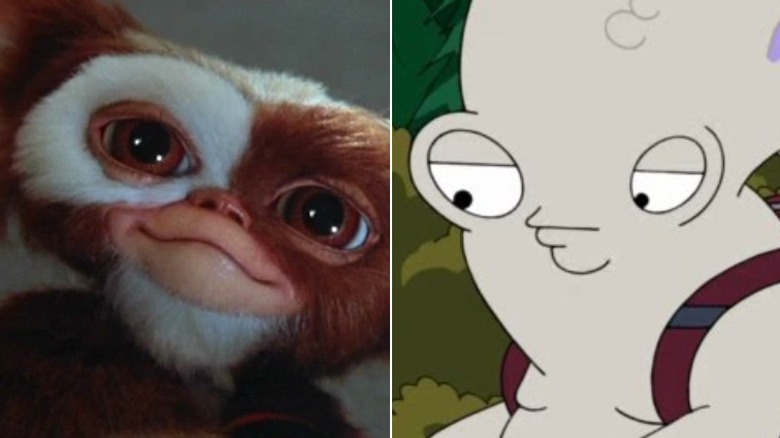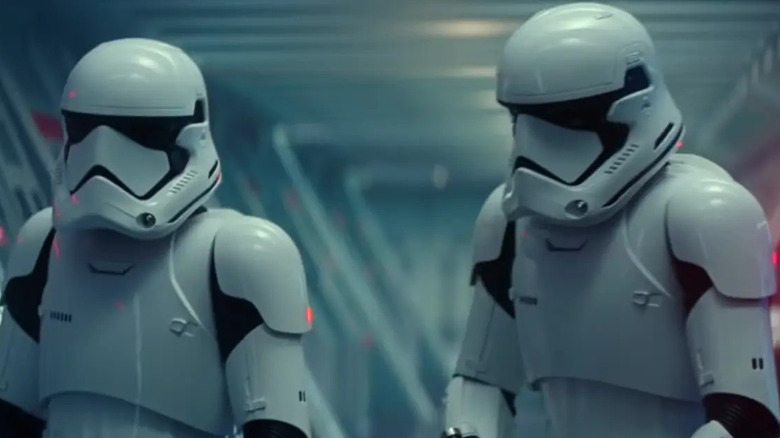The Mandalorian: Things Only True Bounty Hunters Know About The Show
Over the past four decades (and counting), "Star Wars" has spawned close to a dozen movies, hundreds of tie-in novels, countless video games, stacks of comic books, action figures, radio dramas, tabletop RPGs, collectible card games, and pretty much every other type of media you can imagine — save one. While "Star Wars" had a number of cartoons to its name, live-action television remained that galaxy far, far away's one unconquered frontier until very recently.
Oh, there were one-offs, like the spectacular disaster known as the "Star Wars Holiday Special" and the made-for-TV "Ewok" movies. As far as an ongoing series are concerned, though? Nothing for years and years. Remember, we live in a world where even "Knight Rider" has four different shows. You'd think that the TV industry would've shown something as big as "Star Wars" at least a little bit of love before the first movie was more than 40 years old.
In 2019, things changed. It was a long time coming, but we finally got the very first live-action "Star Wars" series, "The Mandalorian."
A different type of Star Wars, but a very familiar story
In October 2018, "Mandalorian" creator Jon Favreau (more on him in a bit) posted a picture on Instagram that evoked the classic "Star Wars" opening crawl and laid out exactly what "The Mandalorian" is about. The series focuses on "the travails of a lone gunfighter in the outer reaches of the galaxy far from the authority of the New Republic," and explores the rocky transition from the Galactic Empire to a brand-new government.
If that makes "The Mandalorian" sound like a Western, that's not an accident. At Star Wars Celebration 2019, Favreau and fellow producer Dave Filoni confirmed that "The Mandalorian," like the original "Star Wars," is heavily inspired by both spaghetti Westerns and Akira Kurosawa's samurai films. Like the heroes in those stories, the Mandalorian is a lone fighter "of questionable moral character" who flies a ship called the Razor Crest and does whatever it takes to survive.
Plot specifics at the time were slim, but we knew that actor Pedro Pascal modeled the Mandalorian on Clint Eastwood, and that the gunslinger runs across a character named Greef, the head of a loose coalition of bounty hunters who have a special mission for the titular character. According to clips shown to the Star Wars Celebration audience, Mando crosses paths with an old Imperial loyalist who wants to see the Empire take back control of the galaxy ... and it sounds like the Mandalorian isn't totally against the idea.
But what is a Mandalorian, exactly?
In "Star Wars" lore, Mandalorians are fierce warriors with a long, proud, and surprisingly complex history. You may not have seen them before, but you're probably familiar with their most iconic creation: Boba Fett wears Mandalorian armor, as did his father, the bounty-hunter-turned-clone-daddy known as Jango.
Mandalore hasn't played much of a role in the movies, but it's a big, big part of the "Star Wars" cartoon shows. In "The Clone Wars," Mandalore has been ravaged after centuries at war, including an old and ancient conflict with the Jedi. When a Duchess tries to establish a pacifist government, a group of exiled warriors strike back, leading to a full-on civil war. Later, Darth Maul (who's not quite as dead as you think) conquers Mandalore, and uses the planet as a headquarters for his criminal syndicate, the Shadow Collective. So, yeah, Maul's brief "Solo" cameo isn't quite as random as it seems.
Sabine Wren, one of the main cast members on "Star Wars Rebels," is Mandalorian through and through. When the series starts, Sabine's been branded a traitor for her role in the burgeoning Rebel Alliance, but politics end up bringing her back. With the help from her teammates, Sabine returns the fabled Darksaber to its rightful home and helps quell another Mandalorian civil war, bringing peace to the Mandalore at long last. Now, given its remote setting, "The Mandalorian" probably won't delve too deep into the planet's pulpy "Game of Thrones"-like politics, but hey! There's always hope for a spinoff...
The clothes that made the man (or the woman)
Here's a little secret: he might dress like one, but Boba Fett isn't actually a Mandalorian, at least not in the new, Disney-ified canon. In "The Clone Wars" episode "The Mandalore Plot," the Mandalorian Prime Minister tells Obi-Wan Kenobi that Boba's dad, Jango, is just a regular ol' bounty hunter who wears someone else's armor.
But, thanks to Boba, we knew what a Mandalorian looked like decades before we knew anything about them as a people, and "The Mandalorian" wouldn't be the same without him. Boba Fett debuted during the "Star Wars Holiday Special," and while the rest of the program isn't worth your time, Nelvana Studios' animated short "The Faithful Wookiee" absolutely is. Not only does the sequence make Fett cooler than the movies ever did — no falling into man-eating pits here — but the design ended up influencing both how the Mandalorians look on "The Clone Wars" and the Mandalorian's costume, too. That big ol' holster, the narrow visor, the natural color scheme, and the visible battle damage? Those are all Nelvana.
The "Holiday Special" short also gave an idea as to what The Mandalorian would look like. In fact, Nelvana's animators looked to Westerns when storyboarding the short. The surreal landscapes of "The Faithful Wookiee" and the dinosaur that Boba rustles and rides might be a little too fanciful for live-action TV, but anybody who wanted to see "Star Wars" reimagined as a spaghetti Western didn't have to wait for the premiere of "The Mandalorian." There was already an example out in the wild.
A galaxy of familiar faces and you won't see any of 'em ... in Season 1
As revealed at the "Solo" premiere, "The Mandalorian" takes place a few years after "The Return of the Jedi," and a couple of decades before "The Force Awakens." At this point, the Rebel Alliance has transformed into the New Republic, while the former Imperials who'd eventually form the First Order are still licking their wounds in the galaxy's Unknown Regions. Leia Organa is busy serving in the Galactic Senate. Her husband, Han Solo, splits his time between taking care of their kid Ben, i.e. the future Kylo Ren, racing spaceships, running his own shipping company, and teaming up with his buddy Lando for the occasional New Republic mission.
None of those folks are in "The Mandalorian." Season 1 of the Disney television show takes place far from the New Republic's capital and features new characters. The Mandalorian looks familiar, but he isn't Boba Fett. You might think you recognize mechanical bounty hunter IG-88 from "The Empire Strikes Back," but that's actually a different assassin droid named IG-11 voiced by filmmaker Taika Waititi ("What We Do in the Shadows," "Thor: Ragnarok").
However, even before a few famous faces arrive down the line, "The Mandalorian" is full of tried-and-true "Star Wars" staples. Season 1 includes Jawa sandcrawlers, lizard-like dewbacks, "Return of the Jedi"-style speeder bikes, and at least one familiar-looking droid.
I'm sorry, Jon... who?
You might've noticed that Jon Favreau's name comes up quite a bit when talking about "The Mandalorian." There's a very good reason for that: the accomplished director is running the whole shebang. As Disney's initial press release states, Favreau is executive producing and writing "The Mandalorian."
In addition to flicks like "Elf," "Zathura," and "Chef," Favreau directed a little something called "Iron Man." You know, the movie that single-handedly launched the Marvel Cinematic Universe, revitalized Robert Downey Jr.'s career, and made Tony Stark a household name? Yeah, that "Iron Man." Favreau also served as a producer on "The Avengers" and helmed Disney's live-action "Jungle Book" and "Lion King" adaptations. In other words, he's got a flair for making special effects-driven dramas that are also full of humor and heart, and he's an old pro when it comes to launching franchises. Sound like a good fit for "Star Wars?" Yeah, we thought so too.
Not only that, but Favreau had already proven his "Star Wars" bona fides before "The Mandalorian" came along. As an actor, he's participated in not one but two separate "Star Wars" projects. If you saw "Solo," you might recognize Favreau as the voice of Rio Durant, Tobias Beckett's multi-armed pilot. "The Mandalorian" won't be Favreau's first dalliance with the show's titular warrior race, either. On "The Clone Wars," Favreau played Pre Vizsla, the exile who started the Mandalorian Civil War, helped the Shadow Collective conquer the planet, and ultimately met his demise at the wrong end of Darth Maul's lightsaber.
The big Rebels connection
When it came to Favreau bringing "Star Wars" to the small screen, he had some help. Longtime Lucasfilm president Kathleen Kennedy is listed as one of the show's producers, and all of the material goes through Lucasfilm's story group, the organization in charge of keeping "Star Wars" canon consistent.
Favreau also gets a big, big hand from the animated side of things. Dave Filoni may not be a household name, but if you're a modern-day "Star Wars" fan, you know his work very, very well. Filoni directed "The Clone Wars" feature film (which, let's face it, isn't really something to brag about), and he worked side-by-side with George Lucas to bring the subsequent, superior animated series to the air. Filoni also co-created both "Rebels" and the "Star Wars" cartoon, "Resistance."
In other words, he's the guy behind a lot of the best parts modern "Star Wars" canon. According to "The Art of Star Wars: The Clone Wars," Filoni is the brains behind Anakin Skywalker's beloved apprentice, Ahsoka Tano. On "Rebels," Filoni and his staff raised questions about the Jedi's relationship with the Force years before Rian Johnson and "The Last Jedi" did the same. Heck, he even voiced Chopper the scene-stealing droid. Naturally, Filoni will be bringing his informed, insightful, and nuanced take on "Star Wars" to "The Mandalorian," too. He's one of the show's executive producers, and he made his live-action directorial debut with the first episode of "The Mandalorian."
The people who make it all happen
"The Mandalorian" isn't short on star power behind the camera. When they were rolling out the show, Disney shared a list of some of the people who directed a few of the Season 1 episodes, and it's a doozy.
Dave Filoni's there, obviously, but by far the biggest name on the docket is New Zealand native Taiki Waititi. You know why that's exciting? Here are a few reasons: "Eagle vs Shark," "Flight of the Conchords," "What We Do in the Shadows," "Hunt for the Wilderpeople," "Thor: Ragnarok." So, yeah, he's pretty good. On the other hand, Bryce Dallas Howard might be best known for her performances in projects like "Jurassic World" and "Black Mirror," but she wanted to get into directing for a while. In fact, Howard already had a number of short films under her belt, and besides, "Star Wars" runs in the family. Her Oscar-winning father, Ron, directed "Solo: A Star Wars Story."
Further down the list you'll find Rick Famuyiwa, director of the criminally underrated "Dope," and Deborah Chow, a television veteran who's worked on shows like "Jessica Jones," "Mr. Robot," "Better Call Saul," and "The Man in the High Castle." Honestly, it's hard to imagine a better lineup, but then again, it's not every day that you get to contribute to a cultural institution.
The end of one journey, and the beginning of another
Now, "The Mandalorian" isn't the first time that Lucasfilm has tried to bring live-action "Star Wars" to the small screen. In 2005, George Lucas announced that a live-action "Star Wars" show was in development. The series, which was eventually known as "Star Wars Underworld," was set between the prequel and original trilogies, and took place on the Imperial capital Coruscant, with a primary focus on the planet's seedy criminal underbelly. Allegedly, about 50 scripts were written before "Underworld" was put on hiatus.
The reason? It's all about the cash, baby. "The scripts were written as if money was no object," "Battlestar Galactica" mastermind Ronald D. Moore, who worked in the "Underworld" writers' room, told EW. According to Lucas, every episode would've been equivalent to a $20 million film, although he claimed he could produce it for a fraction of that by using his own facilities and digital technology. He wasn't willing to compromise his vision, either. If that meant postponing production until the special effects could be accomplished on a TV budget, well, then he'd just wait. That was 2011. In 2012, Disney bought "Star Wars" for $4 billion, and "Underworld" suddenly went into limbo.
In 2013, ABC's Paul Lee said that Disney, ABC's parent company, was reevaluating "Underworld," and when Jon Favreau's series was announced, many fans wondered if some of "Underworld" (and "1313," the canceled "Underworld" video game tie-in) would make its way into the new project. Given what we know now, probably not, although "The Mandalorian" inherited at least one thing from its predecessor: the price tag. Reportedly, every episode of the show cost $10 million to make. Yikes. And that was just for Season 1, before the show became a massive hit.
A cast that's out of this world
Pedro Pascal — at one point best known as the dude who had his head crushed by the Mountain on "Game of Thrones" – is the man behind the Mandalorian's signature armor. He was never the only established actor attached to the show. For "The Mandalorian," Disney and Lucasfilm assembled a top-tier cast that's full of genre-fiction favorites.
In Season 1, former MMA star and American Gladiator Gina Carano played Cara Dune. Carl Weathers, noted for his performance of Apollo Creed in "Rocky," portrays Greef Marga. Critically acclaimed director Werner Herzog stepped in as a pro-Empire crime lord, while Star Wars Celebration footage revealed that "Breaking Bad" and "Better Call Saul" villain Giancarlo Esposito plays ex-Imperial officer Moff Gideon.
But wait, there's more! The Mandalorian tapped Academy Award nominee Nick Nolte, and fleshed out its cast with comedian Bill Burr, Emily Swallow of "The Mentalist" and "Supernatural," and Omid Abtahi of "American Gods."
Seasoned with that old-school flavor
At Star Wars Celebration 2019, Jon Favreau repeatedly emphasized that "The Mandalorian" would be one giant love letter to the original "Star Wars" trilogy, and that tribute extends behind the scenes as well. Favreau wants to make sure "The Mandalorian" feels like our first visit to that galaxy far, far away, and that means embracing some old-school film production techniques. Naturally, green screens and CGI are necessary to deliver "The Mandalorian" on a TV budget, but Favreau says that the crew is also using puppets, animatronics, and special effects makeup wherever possible.
For example, while the dogfights in the modern "Star Wars" films are mostly computer generated, Favreau really wanted to make a model of the Razor Crest to use during production. Well, Industrial Light & Magic's art staff were so excited about the idea that they didn't just make a model. Unprompted, they went home and built a camera rig in their garages, recreating the hardware that was used to make "Star Wars" back in 1977. The end result looks just like classic "Star Wars" films. It's very cool.
A trailer that delivers on every promise
The first trailer for "The Mandalorian" dropped at Disney's 2019 D23 Expo, and while it's only a minute and a half long, it's crammed full of good stuff. Gorgeous cinematography that evokes old spaghetti Westerns? References to "Star Wars" films from every era, even the made-for-TV "Ewok" movies and the infamous "Star Wars Holiday Special?" First looks at a whole bunch of colorful new characters, as well as some nods towards old favorites? It's all here.
"Mandalorian" creator Jon Favreau promised a series exploring the "darker, freakier side" of the galaxy, and he wasn't kidding. Pedro Pascal's masked bounty hunter doesn't utter a single line during the video. He doesn't have to. Actions speak louder than words, and "The Mandalorian" trailer is full of action, including one of the most gruesome deaths in "Star Wars" history. (It involves a closing security door. You'll know it when you see it.)
The George Lucas connection to The Mandalorian
All of "Star Wars" owes a huge debt to George Lucas — after all, the man created the entire darn thing — but "The Mandalorian" has some specific ties to the great maker of "Star Wars." For one, the show is heavily inspired by the first "Star Wars" movie, especially the opening act and the cantina scene, which Lucas directed. (Lucas was creatively involved with "The Empire Strikes Back" and "Return of the Jedi," but didn't actually helm the features.) "The Mandalorian" also uses technology originally developed for the "Star Wars" prequels, with 20-plus years of technical advancements added in.
However, as "Breaking Bad" and "Mandalorian" villain Giancarlo Esposito revealed, Lucas' input on the series goes a lot deeper than that. According to Esposito, Lucas actually contributed some creative ideas to the show. While discussing the impressive roster of directors working on "The Mandalorian" with Collider, Esposito said that "Mandalorian" creator Jon Favreau "figured it out with George Lucas" himself, and was "working with George Lucas" directly.
Lucas and Favreau must've gotten along, because Lucas stopped by "The Mandalorian" set to surprise Favreau for the showrunner's 52nd birthday. Disney might be calling the shots at "Star Wars" these days, but Lucas' contributions certainly haven't been forgotten.
Video games helped bring The Mandalorian to life
From the original "Star Wars" arcade game to '90s classics like "TIE Fighter" and "Jedi Knight" to "Knights of the Old Republic" and "Jedi: Fallen Order," "Star Wars" and video games have always enjoyed a healthy relationship. "The Mandalorian" pushes it to the next level. While Jon Favreau and his team used practical effects as much as they could to capture the hand-made charm of the original "Star Wars," digital wizardry was key to bringing the exotic world of "The Mandalorian" to life.
Favreau has a fair amount of experience working on primarily digital movie sets. He's the man behind Disney's live-action "The Lion King" and "The Jungle Book" remakes, and he brought all of that know-how to "The Mandalorian," which was filmed largely using green screens. So, how did Favreau and the actors know what their fictional locations were supposed to look like?
By using a game engine, of course. Video game software is great at rendering detailed 3D environments in real time, and "The Mandalorian" team used that tech to create digital sets that the cast and crew could "film" and see the results in real time. Not only did that speed up production. It let the creative minds involved get an excellent read on what the finished product would look like and adjust accordingly. The results should speak for themselves.
The Mandalorian Season 2 was never in question
"The Mandalorian" was basically a hit before it premiered — or, at the very least, Disney seemed extremely confident about its success. Months before "The Mandalorian" debuted, Jon Favreau got the greenlight to start writing Season 2. By the time that the cast and crew started making the rounds to promote the first season, filming on the second was already underway.
"The Mandalorian" Season 2 adds a couple of new directors to its already stacked lineup, which includes Favreau, and cast member Carl Weathers also directed a Season 2 installment. In fact, his interest in sitting in the director's chair was one of the main reasons why he joined the series. Additionally, "Desperado" and "Spy Kids" director Robert Rodriguez helmed a Season 2 episode on his way to running the whole show on "The Book of Boba Fett" a year later. Peyton Reed — perhaps most famous for all three "Ant-Man" movies — directed two episodes of "The Mandalorian" Season 2.
The Empire is gone, but not forgotten
The beginning of "The Mandalorian" takes place about five years after "Return of the Jedi" and 25 years before "The Force Awakens," making the galaxy a very different place than what we might be used to. The ragtag Rebel Alliance has transformed itself into the New Republic, a representative democracy that spans many known planets. At this point in "Star Wars" canon, the New Republic is in full swing, with a headquarters on the planet Chandrila. It has also passed the Military Disarmament Act, which drastically scaled back the New Republic's military, leaving behind only a small peacekeeping force.
The Galactic Empire, on the other hand, hasn't been as fortunate. After the Battle of Jakku brought the Galactic Civil War to a close, what remained of the main Imperial fleet retreated to the mysterious Unknown Regions, where it will eventually reform into the First Order. Not yet, though. The First Order is still years away.
It's a time of transition. Out on the Outer Rim, where "The Mandalorian" mostly takes place, former Imperial warlords are scrambling to hold on to power. Former rebels are trying to figure out where they belong now that the fighting has stopped. Criminals try to profit off of the confusion, and the main characters are all caught right in the middle of it.
The Mandalorian is the result of a creative merger
"The Mandalorian" is the first live-action "Star Wars" series and it was the first original series to debut on Disney+ when the streamer launched in 2019. According to Vanity Fair, when "Star Wars" production company Lucasfilm decided to pursue small-screen storytelling, president Kathleen Kennedy commissioned input from "Iron Man" director and known "Star Wars" enthusiast Jon Favreau.
Favreau got to work after a single meeting with Kennedy, writing the first four episodes of a show about a Mandalorian, a member of a race of helmet-wearing bounty hunters. There could have been an issue with overlap, as Lucasfilm at the time was also developing a movie about the best-known pre-existing Mandalorian in the "Star Wars" saga, Boba Fett. That problem disappeared when that project's director, James Mangold, walked away to make the fifth "Indiana Jones" movie. However, Dave Filoni, the creative force behind several animated "Star Wars" projects, also wanted to make a TV show about a Mandalorian. Kennedy put Favreau and Filoni in a room, and they got along so well creatively that they combined their ideas into a single project, which became "The Mandalorian."
The classic pop culture that inspired The Mandalorian
As it's set during the storyline of the original, 1977-2019 "Star Wars" saga, "The Mandalorian" is obviously inspired by classic science fiction. Creators, writers, and producers also pulled heavily from other sources, including Westerns, 20th century world cinema, and Japanese manga. "The Mandalorian is a mysterious, lone gunfighter in the outer reaches of the galaxy. Some might say he has questionable moral character, in line with some of our best Westerns," star Pedro Pascal told Entertainment Weekly. The main character's identity is shrouded in secrecy, not unlike the Man with No Name in Sergio Leone's "Dollars Trilogy" with Clint Eastwood. "He's got a lot of Clint Eastwood in him," Pascal added.
Series producer and writer Dave Filoni admitted to paying homage to Japanese filmmaker Akira Kurosawa, who influenced "Star Wars" creator George Lucas. "George's mentor is Akira Kurosawa. And so I've done a lot of study of that," Filoni told /Film. "I have a really small Akira Kurosawa figure and he is in every episode I've directed somewhere in the set."
And according to Den of Geek, "The Mandalorian" cribs from "Lone Wolf and Cub," a long-running manga series adapted into three films. Like Mando and Grogu's toiling around the galaxy, "Lone Wolf and Cub" concerns a ronin who roams the wilderness with a child he protects when they run afoul of powerful forces.
Baby Yoda was a well-kept secret
When the first episode of "The Mandalorian" hit the Disney+ streaming service in 2019, it came with a big reveal and season-long plotline that hadn't been mentioned in any media or trailers that preceded the series. The show's first span of episodes revolve around the Mandalorian ferrying and protecting "The Child" — quickly nicknamed "Baby Yoda" by fans because the creature looks like a smaller, younger, and cuddlier version of the swamp-dwelling Jedi Master from the original "Star Wars" trilogy. The entire operation of "The Mandalorian" worked hard to ensure that the existence of Baby Yoda would be kept secret.
Series creator Jon Favreau decided to go that route after heeding the words of Donald Glover, who played Lando Calrissian in "Solo: A Star Wars Story" and adult Simba in the Favreau-directed 2019 remake of "The Lion King." "He was saying that what people really like now is to be surprised, because it doesn't happen that much," Favreau explained to The Hollywood Reporter. "When Beyoncé did an album, she would just put it online and everybody would react to it. Just putting it out there spurred a conversation that would become more viral and bring more genuine attention than any marketing." Disney executives agreed with the approach, and even kept all imagery of Baby Yoda out of marketing materials, giving up what would likely have been a fortune in revenue generated by merchandise sales for the 2019 holiday season.
The unique ways actors got their roles in The Mandalorian
Before "The Mandalorian," Pedro Pascal was best known for his role as Oberyn Martell in "Game of Thrones." When producers of "The Mandalorian," the first live-action "Star Wars" series and a Disney+ exclusive approached him about the role, he was apparently reluctant. It took the urging of another "Star Wars" player, his close friend (per Esquire) Oscar Isaac — Poe Dameron in the "Star Wars" sequel trilogy — to get him to agree to play the interstellar mercenary. "You're welcome," Isaac told Wired. "I convinced him to do it."
The Jedi Ahsoka Tano first appears in Season 2 of "The Mandalorian." The character previously appeared in multiple animated "Star Wars" projects, portrayed by voice actor Ashley Eckstein. For the live-action version of the character, producers hired Rosario Dawson, the result of a successful viewer campaign. "It first came from fans online. Someone tweeted me and fan-cast me. I retweeted back and I was like, 'Absolutely, yes please,'" Dawson told Vanity Fair. Someone on the "Star Wars" publicity team caught the exchange and sent the thread to "The Mandalorian" producer Dave Filoni, which got him seriously thinking about the actor.
The Mandalorian may have leaned too hard on Gremlins and American Dad!
The creative team behind "The Mandalorian" took inspiration from many mid-20th-century works. But they may have borrowed a little too liberally from some more recent pop culture entries. Joe Dante directed both "Gremlins" and "Gremlins 2: The New Batch," and he believes that "The Mandalorian" breakout character Baby Yoda, aka Grogu, owes a lot to Gizmo, the furry little creature from his films. "I think the longevity of ['Gremlins'] is really key to this one character, who is essentially like a baby," Dante told the San Francisco Chronicle. "Which brings me, of course, to the subject of Baby Yoda, who is completely stolen and is just out-and-out copied. Shamelessly, I would think."
"American Dad!" has been running — first on Fox, then on TBS, since 2005. In the episode "Persona Assistant," which first aired in February 2019, the alien character Roger develops a tumor, which turns out to be a strange, sentient, miniature version of himself. He names the monster, which becomes a recurring "American Dad!" character, Rogu. Baby Yoda appears in the first episode of "The Mandalorian," which aired later in November 2019, while his actual name, Grogu, was revealed in a November 2020 episode. That makes for two alien babies with nearly identical names.
The Mandalorian called on some Fandalorians
Season 1 of "The Mandalorian" wraps up with a confrontation between the titular bounty hunter and villain Moff Gideon. The Mandalorian refused to return Baby Yoda to his dangerous, intended recipient, and had to contend with a veritable army of stormtroopers. Dressed in the familiar "Star Wars" costume of white uniforms with black elements and head-covering helmets, a lot of those anonymous foot soldiers were required for the scene — so many that the production couldn't come up with enough authentic stormtrooper costumes.
According to Twitter, the makers of "The Mandalorian" took their problem to "Star Wars" fans. Producers Dave Filoni and Jon Favreau called upon the Chicago chapter of the 501st Legion, a devoted "Star Wars" fan club and cosplay club. Its members appeared in two Season 1 episodes of "The Mandalorian," dressed in their privately owned, film-quality stormtrooper costumes which they'd purchased, built, and maintained.
